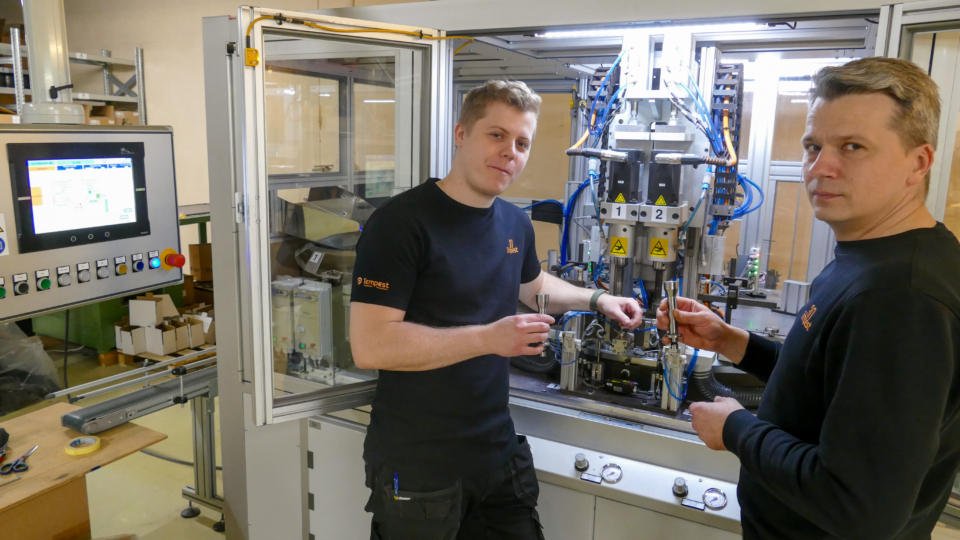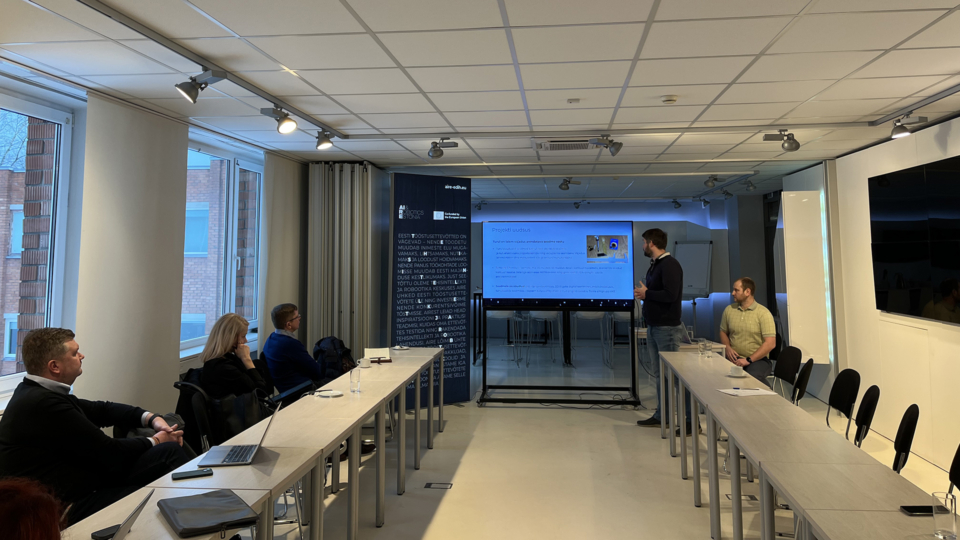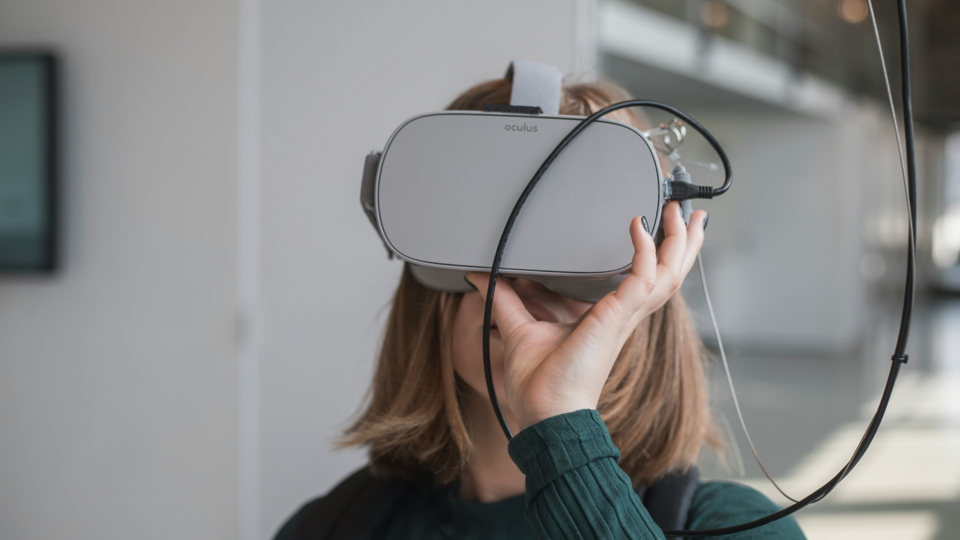AI expert: Digitisation is not a sprint but a multi-event race
Tõnis Raamets, a PhD student at TalTech, is a researcher and engineer with over 20 years of experience in the automotive industry and manufacturing. Over the past year, he has been AIRE’s project manager for two demonstration projects where companies found solutions to improve their bottlenecks through digital twin and artificial intelligence.
According to Raamets, the role of the Tallinn University of Technology in these projects is multi-level: providing the infrastructure, science-based knowledge and human resources for companies to implement their digital solutions. “The university makes its choices in the composition of the working groups according to the purpose of the project. If necessary, we will involve experts from other universities or science parks. In the case of Chemi-Pharm, we had the necessary expertise in-house and there was no need to bring in specialists from outside,” explains Raamets. The people involved in the projects are usually split fairly evenly between the university and the company. Chemi-Pharm had 7 people from the university side and 6 from the company, while Scandinor’s project had 4 of its own staff and 7 researchers.
Digital twin for business
“There are a number of ways to approach the problem of artificial intelligence. We were tasked by Chemi-Pharm to create a smart AI-based management system for production logistics, which would suit the company, as their own staff are busy with the day-to-day management of production problems and therefore do not have the opportunity to engage in in-depth development work on production logistics. One of the things we can offer them in such a situation is the creation of a digital twin, or virtual factory, which is one of the steps we have taken,” Raamets explains. He added that the digital twin environment allowed the work to be done outside the real company. The machines were equipped with sensors and the work was done in a simulation environment. As the company already had a digital twin from a previous project, it was necessary to make ongoing upgrades according to today’s data. This data could in turn be used to analyse and develop the artificial twin for a specific challenge.
“It gives a lot more opportunities for companies and it’s not just about the artificial intelligence side, it’s about everyone involved in the factory: subcontractors, robotisation solution providers, employees. There are a lot of things that can be done on a virtual factory basis,” he said. “The data in the virtual factory will become, or more precisely has already become, a Marketplace for companies to transact. On the basis of this data, research development can be offered and the company can focus on its core business.” Raamets sees this as freeing up resources for companies, as they no longer have to deal with ten things. At some point, it will provide the opportunity to offer new services and solutions based on Marketplace data – a moment he says could be quite interesting. “I can already see that workforce problems can be solved in a way that an employee can come from another country – for example, driving a robot can be done remotely. There are a lot of positive things that can come out of this,” says Raamets.
Bigger picture
Raamets said it was important to stick to the initial target set for the duration of the project to maintain focus. In addition, the duration of the Chemi-Pharm project was very short in their terms – six to nine months – which forced them to stay focused in order to reach the target. The main focus was on creating an artificial intelligence-based production logistics management system that would help to reduce production downtime at the workstations and could also be interfaced later with autonomous mobile robots to transport materials on the factory floor.
As project manager, he stressed that the most important thing is to get enough data from the company to be analysed further. “Even if the company does not have enough data, we can use Dimusa, the web-based production tracking system developed by the Faculty of Mechanics. This allows us to get a real-time snapshot of the current situation, from production equipment and workstations to productivity and working time. Based on the data, we can use artificial intelligence tools to identify bottlenecks that can be optimised in the company,” he explains.
Raamets sees that most demo projects have the potential for follow-on projects that companies can develop further, but require investment to create the infrastructure that the artificial intelligence will use as input. “When it comes to new opportunities, for the AI to work further, data needs to be collected further and corrective proposals need to be made based on that data,” he said. “It’s a bit of an outlandish way of doing things for companies and that’s why I see the need to train people on the job to understand what does what. It would take people’s fears away if they understand the working principles of robotisation and digitalisation,” he said. Adding that if there is too much misunderstanding, people will start to resist.
“Others have said that digitalisation is not a sprint, but a multi-event, that all things take time to get used to. It’s just a matter of starting processes and going through stages. The analogy of climbing a ladder is a good one, you can’t skip five steps and jump straight up. Of course, at the university, with every project we do, competence also increases. If we know more, we can also guide more. On the one hand, some jobs may be cheaper, but on the other hand, technology is developing so fast and new information is coming in all the time,” laughs Raamets. “I would recommend everyone to start working with AI and try it out, because AI can already make a number of recommendations based on data analysis. It’s already like a little advisor telling you to look at one piece of work or another.”
More options
According to Raamets, what made Scandinor’s project interesting is that they do not have a new plant, but they want to build one. “In this case, when we created the digital twin, we played out the production processes. Since it is important for them to find investors to build a factory, the simulation we created helps them to go to investors and show the production processes, what the volumes are and the possibilities for expansion,” he explains. “I’ve said the same thing to other companies – start creating a digital twin next to the real factory, where you can prepare production changes to improve the business or change contracts with suppliers – these are completely new opportunities. We’ve taken the starting position when developing these projects that the code is open to everyone anyway, plus we’re constantly adding these new functionalities to our own production tracking platform Dimusa.” Raamets encouraged companies to create digital twins.
Assessing the progress of the Scandinor’s project, Raamets said that the level of competence of the researchers working at the university has also started to rise with each project. “It’s good to see that we haven’t had any setbacks, but rather that we have reached a new level. We have already done a lot with the virtual campus and the artificial intelligence. The way the artificial intelligence is able to identify production problems in seconds is incredible and worked well in terms of equipment availability, job availability, performance and quality indicators, and we were able to find out the exact reasons where to apply corrective measures,” Raamets enthused.
According to him, students at the Tallinn University of Technology who are already familiar with the field have also been trained for the companies but it will take time before they start making real changes in the companies.
Good to know
- Chemi-Pharm’s demonstration project focused on organising and visualising the company’s day-to-day production logistics through a smart artificial intelligence-based management system, which contributes to increasing production throughput and production process efficiency.
Duration of the project: 1.11.2023-31.05.2024 and financed by the European Commission with a budget of EUR 48 000.
- Tõnis Raamets has a long-standing involvement in the management of the Estonian Engineering Federation. He is currently working at Tallinn University of Technology as a doctoral candidate. His main research area is the development and implementation of digital optimisation and control models in production processes. Tõnis will be a member of AIRE from the beginning of 2022.
- The Data Marketplace is a trading platform that brings together suppliers, service providers, universities to transact using corporate data.
Videos of demo projects:
Photo: AIRE demo project video, Tiit Loo





